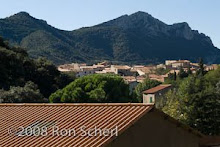
There is a photograph which frames Limoux for me. A woman wearing a red sweater has posed herself before what must be the door of her wine cellar. It is a door that has seen many seasons, as has the woman. Her left hand is raised to tidy her hair and she is smiling.
She is timeless, the woman in the picture, like Limoux. I always feel freed of the tyranny of time there. The clocks have been stopped. We move in pre-history, the cycle of the vine and the field.. Maybe it’s because Limoux is a geographic and geological tangle. It is neither quite Mediterranean or quite Atlantic. It can be chilled one day by winds off the Atlantic and warmed the next day by a Mediterranean breeze. But the map says Limoux is in Languedoc. You can’t argue with that. Once again, the map has failed the territory.
Back to the woman. I know from the title of the picture that she must be selling wine at the cellar door. Most likely she and her family make Blanquette de Limoux, a sparkling wine that, according to the locals and even some reasonable wine historians, was made here long before they started making bubbly in Champagne. There is even a tale that Dom Pérignon, the monk said to have invented Champagne---you remember him, the guy who said he was drinking stars---learned the art in the Benedictine abbey of Saint-Hilaire in Limoux.
Certainly the woman in the red sweater would believe that. She would also know that the first mention of Blanquette de Limoux is in 1531 in records from the abbey. (Blanquette means white in the old Occitan tongue.) This knowledge can be seen in her eyes, the way they looked straight out at the Photographer. She and her family have been making wine since before the weather-beaten door was hung in place. She knows the thin rocky soils of the Pyrenees foothills, the harsh winter winds and the soft fairy green of spring. She knows that an hour’s drive south is Mount Canigou, the sacred mountain of the Catalans.
Blanquette de Limoux, like sparkling wines wherever they are made, is disgorged from the bottle after secondary fermentation and rebottled with a dosage added. It is a splendid wine with bright lively flavors and good depth of flavor. It was a favorite of Thomas Jefferson, a man who knew his wine. At his death, Blanquette de Limoux made up 10 per cent of his cellar and was the only sparkling wine in it.
If we are lucky, she will also make a little Blanquette Méthode Ancestrale, just for family and friends. Perhaps she can spare us a bottle or two? Her tentative smile grows wider, pleased that we know of Méthode Ancestrale. It is a wine that has simply stepped aside and let the industrial revolution rush right past, gears grinding. Time out. Tear the hands off the clock, for Méthode Ancestrale keeps time by the moon. The French call it a vin mystérieux.
It is bottled always in March and at its best if bottled under a waning moon. Only natural yeasts are used in fermentation and they are never in a rush, so the wine is only partially fermented when bottled. The alcohol content is only six or seven percent. The wine is often a bit murky, what with all those dead yeast cells hanging about and it will be a little sweet because of the unfermented grape sugar. There will also be a little lingering fermentation taking place, giving the wine a charming fizziness but making it virtually impossible to ship. You want Blanquette Méthode Ancestrale straight from the cellar door, straight from the woman in the photograph.
There is no denying that the Ancestrale is a moody wine, sometimes mute and sulky. But at its best, an underlying earthiness forms the base for a virtual banquet of aromas dominated by rich apple flavors. There are some wrong-headed writers who dismiss the wine as a mere summer sipper. The woman in the red sweater would shrug her shoulders and shake her head at such foolish talk.
She knows that Blanquette Méthode Ancestrale is a richly satisfying wine, yielding its charm only to those who pay attention and respect it as a link to an age when time was measured in vintages and the waxing and waning moon was the common calendar.
Limoux is on the N620, about midway between Perpignan and Foix and directly south of Carcassonne. If you want to taste at the cellar door watch for signs reading vente du vin. You can also check in at the Syndicat des vins AOC de Limoux at 20 Avenue du Pont-de-France in town (04 68 31 12 83) for a list of wineries open to visitors.
Grapes used in Blanquette de Limoux are Mauzac (called Blanquette locally), Chardonnay and Chenin Blanc. Only Mauzac is used in the Méthode Ancestrale.
Larry Walker

